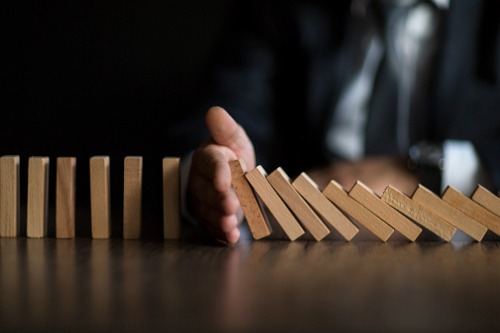Will social distancing be the space’s downfall?

As U.S. unemployment figures rise and more businesses are put out to pasture by COVID-19, those that have so far survived the country’s latest recession are desperate for a return to whatever new iteration of ‘normal’ will allow them to start rehiring workers, generating profits and paying their landlords. But according to Whalen Global Advisors chairman R. Christopher Whalen, the prospects facing the nation’s commercial space are growing darker and more nauseating by the day.
In a post written for The Institutional Risk Analyst on Thursday, Whalen predicted “financial Armageddon” for both commercial real estate and the cities that depend on it for tax revenue.
“We certainly do know that the world of commercial real estate will be really, really dreadful in the next several years,” Whalen writes. “Default rates could exceed peak losses of the 1990s by a wide margin.”
Ironically, the biggest threat to the health of commercial real estate is the same one protecting the health of the country’s citizens: social distancing.
Social distancing has already changed the retail experience for stores that have been allowed to reopen. Fewer shoppers being allowed in a building means the kinds of lines people have grown accustomed to standing in outside grocery stores or pharmacies will soon be coming to most retail businesses. There are few everyday retail experiences most people will be willing to stand in extended lines for, especially at the height of summer. (Ice cream shops, maybe?) Who is going to want to stand in line at the mall, that former bastion of convenience? According to Forbes, nobody.
“For a whole host of reasons,” wrote Forbes senior contributor Pamela Danziger, “I believe shoppers are going to avoid malls ‘like the plague’ once the immediate COVID-19 threat subsides.” And that was back in March.
Restaurants face a similar challenge – fewer dine-in customers, fewer profits and fewer tips to entice a steady supply of wait staff. Multi-family construction will suffer if large numbers of the unemployed aren’t put back to work. The office and industrial spaces will face their own challenges around providing a safe work environment, but neither requires a steady flow of foot traffic to keep income flowing; unless these offices provide back-end support for struggling retail or restaurant chains.
But even with these challenges facing it, the commercial space may not be ready for the graveyard just yet.
"‘Armageddon’" feels strong as a blanket statement for the industry as a whole,” says RealCrowd CEO Adam Hooper. “Yes, certain sectors have been crushed and there will be long term impacts and unknowns as to how they recover, but there are still some very strong fundamentals that make the case for real estate as a healthy place to invest capital.”
Falling dominoes and flaming holes
Whalen’s overriding concern is the flaming hole that a faltering commercial sector can leave in a city’s balance sheet. Citing a New York Times article by Matthew Haag, Whalen explains that a decline in rent being paid to commercial landlords can only result in a drop in tax payments to local governments, whose finances have already been spread wafer thin by COVID-19.
“Two months into the crisis,” wrote Haag on May 21, “the steep drop in rental income now threatens [commercial owners’] ability to pay bills, taxes and vendors — a looming catastrophe for [New York City], they warn.”
New York, despite being the epicentre of the coronavirus outbreak, will not be alone in trying to mitigate this colossal shortfall. The National League of Cities calculated that U.S. cities could face an overall revenue shortfall of $360 billion between 2020 and 2022.
“[W]e project that the portion of revenues for cities, towns and villages generated by sales and income taxes will have the largest relative fiscal impact on budget shortfalls, followed by revenues generated by fees and charges[, and] then property tax revenues,” the NLC staff wrote on May 14.
Because the fate of commercial real estate rests with the planet’s wildest of wild cards – human beings – there remains the distinct possibility that if social distancing doesn’t give pent-up shoppers or desperate store owners the results they’re hoping for, they will be all too happy to crowd into commercial spaces and behave as if social distancing never happened.
“It will be really interesting to see how these competing desires duke it out in our psychology,” says Adam Hooper, CEO of RealCrowd. “I think we've already started to see some people think that enough has been done and they're just ready to get back to life, but at what cost? My fear is if we get back to normal too quickly, we'll face a spike in infection rates which will inevitably lead to a rolling or revolving shutdown, which could be even more catastrophic to the economy and consumer confidence than the lumps we’re taking right now.”
It wouldn’t be the first time profit and short-term convenience have been given priority over the public good, but for any businesses willing to risk their customers’ health for the sake of making rent and covering payroll, it could be the last.



